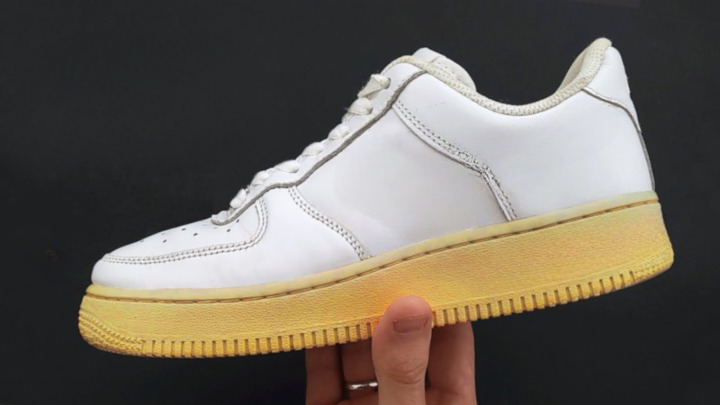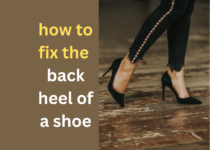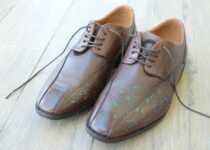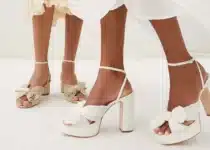How to Remove Yellowing from Shoes Soles
Table of Contents
Are your shoes getting dirty, drab, and yellow? A shoe’s worth is immediately diminished by dull or yellowed soles. In this article, you will find real-life proven methods for restoring the original color of your shoe soles, whether they are trainers or dress shoes everyone trying to search for How to Remove Yellowing from Shoes Soles.
Learn everything from do-it-yourself (DIY) procedures to professional (professional) approaches to restore those faded soles with a small investment in materials and tools.

let’s explain How to Remove Yellowing from Shoes Soles
You may be wondering what caused the yellowing of your shoe bottoms if you’ve recently observed it. Dirt and grime, oils from the skin or sweat, environmental conditions like humidity or rain, and oxidation due to age are the typical culprits in yellowing. The cumulative effect of these factors is a noticeable yellowing that, if left unattended, may be difficult to eradicate. Shoes with rubber soles are especially susceptible to this problem since they absorb oil and grease.
7 Methods of How to Remove Yellowing from Shoes Soles
1. Paste made of baking soda and water
Make a paste by mixing baking soda and water to use as a tooth cleaner and breath mint. To make a paste you have to combine baking soda and water in a small basin and whisk until it gets smooth.
2. Vinegar and Water
Since vinegar is acidic which is normally used to cut through grease and grime on hard surfaces. Cleaning with vinegar and water is as easy as filling a spray bottle with equal parts of white distilled vinegar and warm water. Next you have to spray solution onto the surface for a few minutes and then remove it with a wet towel. However, you shouldn’t use vinegar on any natural stone, like marble, granite, or limestone. The surface may become etched and the polish may become dull. Instead of using harsh chemicals on these surfaces, a solution of water and dish soap should be used.
3. A Remedy Comprised Mainly of Lemon Water
To diminish the look of age spots, try using lemon juice, another all-natural cure. The ingredients for this home treatment are as simple as a dish of lemon juice and water. To use, simply soak a cotton ball in the solution and apply it to the affected skin. After ten minutes, rinse it off with cool water. For optimal results, do this twice daily. If possible use freshly squeezed lemon juice instead of the concentrated one you buy in the supermarket. To avoid skin irritation, those with sensitive skin should dilute the mixture with more water. After applying the solution, you may also feel a brief stinging or tingling sensation. To prevent future skin damage, constantly use sunscreen and reduce your time spent in the sun.
4. Solution of Hydrogen Peroxide and Water
Homemade hydrogen peroxide is another green cleaning option. It has many uses, including disinfecting surfaces and fabrics. One component of hydrogen peroxide to four parts of warm water creates a hydrogen peroxide and water solution. This product is safe for use on tiled floors and walls.
To prevent yourself from Hydrogen peroxide make sure you wear gloves and goggles whenever you work with it. To prevent discoloration or damage, the solution should be tested on a small area first after that you can apply it on larger area.
5. Baking soda and lemon juice
Baking soda and lemon juice are excellent all-natural cleaners. The lemon’s acidity aids in dissolving filth and grease, while the baking soda acts as an abrasive to wipe away stubborn stains. Make a mixture of half a cup of fresh lemon juice and one spoon of baking soda. Stainless steel, tile, and other hard surfaces can all benefit from this cleaning solution. After washing, give the area a last rinse with cold water and a thorough drying with a soft cloth. Do not use this solution on marble or other porous surfaces, as they may be damaged.
6. Solution of Alcohol and Water for Rubbing
Surfaces can be cleaned and disinfected effectively using rubbing alcohol. Make a disinfectant spray by mixing five parts of water with one part of rubbing alcohol in a spray bottle. The alcohol in this solution might damage unpainted wood, so take care not to use it there. Rubbing alcohol is toxic if ingested or inhaled, therefore avoid doing either. The rubbing alcohol and water combination works best if sprayed on a clean surface and then wiped clean. After applying the solution, let it dry naturally. Mold and mildew are no match for this type of disinfectant.
7. Oxygen Bleach
When compared to chlorine bleach, the solution of oxygen bleach is a far gentler sanitizer and disinfection for surfaces. One cup of oxygen bleach in two gallons of warm water makes a solution that can be mopped or sponged onto the surface. After 10 minutes, carefully rinse the area with clean water to remove any traces of the solution. Mold and mildew are particularly easy to eliminate with oxygen bleach in damp environments like bathrooms, kitchens, and laundry rooms. Scrubbing the area with a brush may be necessary before applying the solution if it is extremely filthy. To prevent mold or mildew from returning, constantly rinse the area and pat it dry after usage. If you follow these guidelines, you can avoid any kind of trouble creating your own homemade natural cleaning products. These options are not only less harmful to the natural world, but they are also less harsh on human skin and household surfaces.
The greatest news is that many of these options are affordable, so you can keep your house tidy without breaking the bank. Make use of these eco-friendly products in your own home today!
How to Remove Yellowing from Shoes Soles: Some Things to think About
1. Find out what kind of material your shoe soles are made of
You can do this by consulting the label or the manufacturer’s information. To get the original color back into rubber, plastic or leather, you might have to try a few different things
2. Always keep your shoes clean:
If you want your shoes to last long and keep looking beautiful, you should clean them regularly. Dirt buildup on the soles, which could cause discoloration or even damage of the material over time, can be avoided with regular cleaning. You can keep your shoes clean with regular scrubbings using mild soap, warm water, and a soft cloth.
3. Invest in more specialized items
You may need to invest in more specialized items to assist eliminate yellowing if the soles of your shoes are made of a stronger material like rubber or plastic. Numerous shoe care products exist that are formulated to eliminate stains and restore a shoe’s original color.
4. Certain home cures
There are certain home cures that can be surprisingly efficient at restoring the original color of your shoes. You can try these if you are in search of a natural way to get the job done. You can prevent your soles from getting Yellow by cleaning them with baking soda, toothpaste or a mixture of white vinegar and warm water.
5. Consider taking your shoes to a professional cleaner
If everything else fails, consider taking your shoes to a professional cleaner who may have access to more powerful cleaning solutions and ways to get rid of the discoloration. It may be expensive but it may be worthwhile if you want your shoes recolored to their original hue.
6. Think about spending money on routine upkeep:
Finally, frequent maintenance can aid in keeping your shoes in top shape and ward off yellowing in the first place. To keep your shoe bottoms from fading, you should clean, polish, and store them properly on a regular basis.
Read :
Read More: Best Comfortable shoes for older ladies
Conclusion
Don’t worry if your footwear is in desperate need of an upgrade. The discoloration on your shoes’ soles can be eliminated with one common household item. If you follow these instructions, you can make your old shoes seem as good as new in no time. Do not be afraid and give it a try. We hope this article on how to bleach soles was of use to you. If you think it would be helpful to your friends please share it on social media. And keep coming back, because we’ll be adding more helpful guides like this one very soon.



